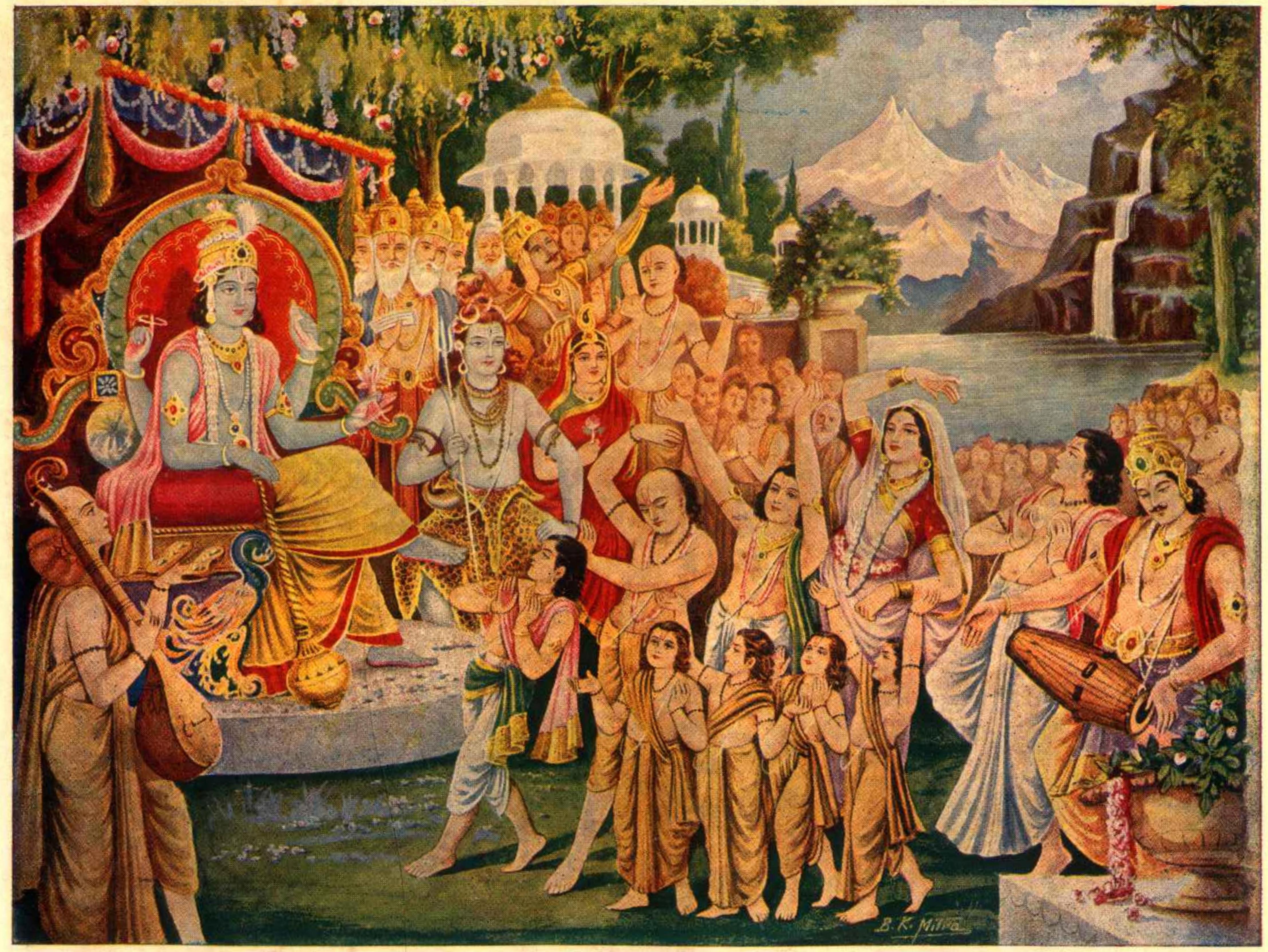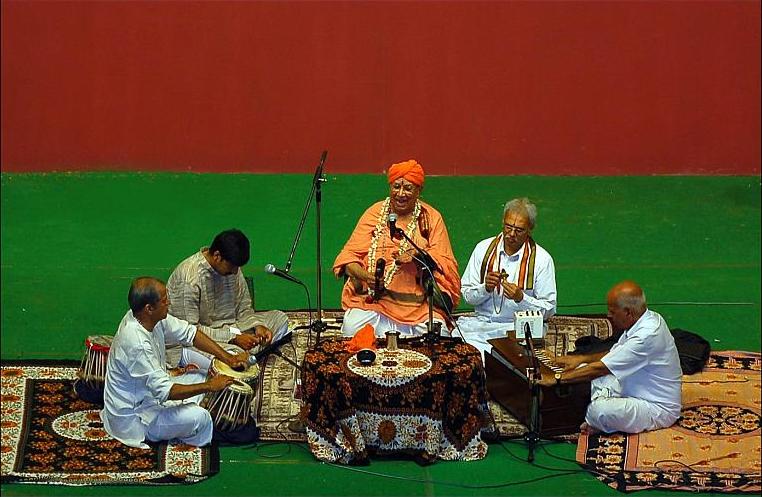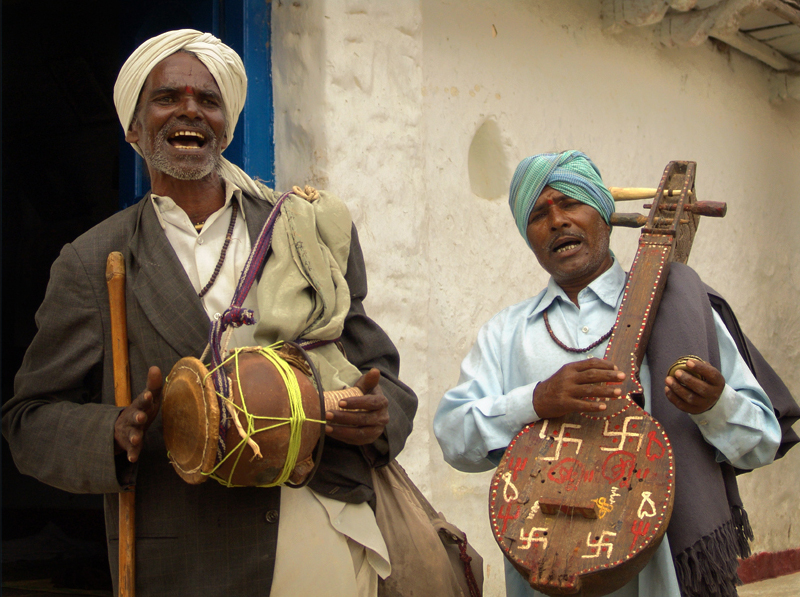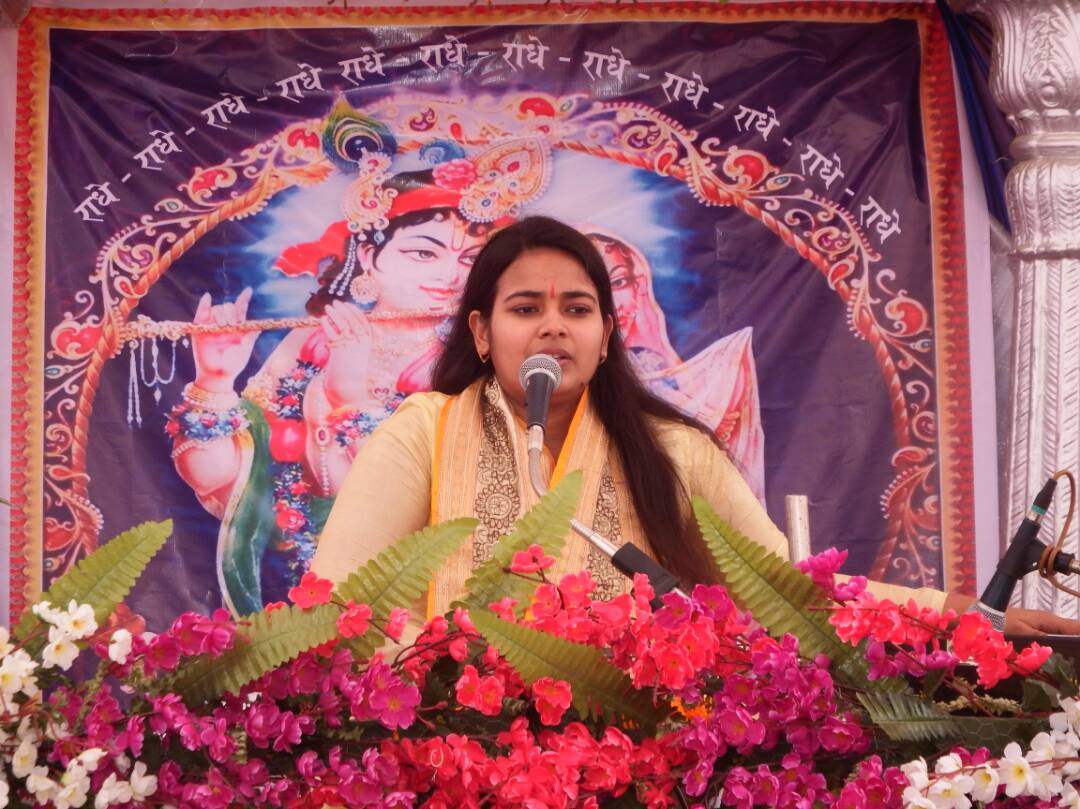|
Oggu Katha
Oggu Katha or Oggukatha is a traditional folklore singing, praising and narrating the stories of Hindu gods Mallana, Beerappa and Yellamma. It originated among the Kuruma (Kuruba)and Yadava communities, who devoted themselves to the singing of ballads in praise of Lord Shiva (also called Mallikarjuna). These tradition-loving and ritual-performing community moves from place to place, narrating the stories of their caste gods. Oggus are the traditional priests of the Yadavas and perform the marriage of Mallanna with Bhramaramba. The story narrated about Lord Mallanna or Mallikarjuna Swamy using the instrument "Jaggu"(damarukam) is known as Oggu Katha. Used at the beginning of each story and also at the marriage festival of Lord Mallanna. Founder of Oggu kathalu was Sri. Vallam Pedda Veeraiah which was continued by his son Vishwa Vikyatha Oggu Katha Sarva Bhoumulu Vallam Sathaiah. The stories, scripts, dialogues and lyrics on Kommaravelli Mallana, Yellama Devi, Nalla Pocham ... [...More Info...] [...Related Items...] OR: [Wikipedia] [Google] [Baidu] |
Mallikarjuna Swamy
Shiva (; sa, शिव, lit=The Auspicious One, Śiva ), also known as Mahadeva (; ɐɦaːd̪eːʋɐ, or Hara, is one of the principal deities of Hinduism. He is the Supreme Being in Shaivism, one of the major traditions within Hinduism. Shiva is known as "The Destroyer" within the Trimurti, the Hindu trinity which also includes Brahma and Vishnu. In the Shaivite tradition, Shiva is the Supreme Lord who creates, protects and transforms the universe. In the goddess-oriented Shakta tradition, the Supreme Goddess ( Devi) is regarded as the energy and creative power (Shakti) and the equal complementary partner of Shiva. Shiva is one of the five equivalent deities in Panchayatana puja of the Smarta tradition of Hinduism. Shiva has many aspects, benevolent as well as fearsome. In benevolent aspects, he is depicted as an omniscient Yogi who lives an ascetic life on Mount Kailash as well as a householder with his wife Parvati and his three children, Ganesha, Kartikeya and ... [...More Info...] [...Related Items...] OR: [Wikipedia] [Google] [Baidu] |
Beerappa
Beerayya or Bheerappa is a God of Kuruma community in India. This community celebrates Beerayya Patnalu Which is celebration of God Beerayya Marriage for every 5 or 7 or 9 years. Beerollu are the traditional priests of kuruma or Kuruba Community and perform the marriage of Beerayya with Kamaraathi. Temple ''Kuruma or Kuruba'' is a caste in Telangana and Andhra Pradesh. Kuruma people worship Beeraiah as their caste god. Kuruma's celebrate the festival called Beerayya Patnalu which is a celebration like ''Jathara'' every 5-10 years. This is the biggest festival in the kuruma community. Relatives, near and far and guests are invited to this festival. Beeraiah Patnalu Beeraayya Patnalu is celebrated for 7 days. Events include Pochamma Bonalu, Mailalu, Ganga Bonam or Jaldi, bonalu, Beerayya Marriage, Sarugu, Post marriage Oggu Katha, and Garadi. See also *Biroba Biroba is a form of Hindu god Shiva. Biroba is the kuldaivat of Dhangars of Maharashtra State. There are many templ ... [...More Info...] [...Related Items...] OR: [Wikipedia] [Google] [Baidu] |
Yellamma
Renuka, also known as Yellamma, is a Hindu goddess worshipped predominantly in the South Indian states of Karnataka, Tamil Nadu, Telangana, Kerala, Andhra Pradesh and western state of Maharashtra. She is also known as the mother of Parashurama, the sixth avatar of the god Vishnu. Originally a Dravidian folk deity, she acquired the status of a mother goddess before eventually being associated with the legend of Parashurama. Names Renuka is venerated by a number of different appellations such as Yellamma, Ekvira, Ellai Amman, Padmakshi Renuka, and Ellai Amma Mahar, Kannada: ಶ್ರೀ ಯಲ್ಲಮ್ಮ ರೇಣುಕಾ, (Marathi: श्री. रेणुका / येल्लुआई, Tamil: ரேணு/ரேணுகை அம்மன், Telugu: శ్రీ రేణుక/ ఎల్లమ్మ) and is worshipped as the goddess of the fallen in the Hindu pantheon. Her devotees revere her as the "Mother of the universe" or Jagadamba. Legends The legends of R ... [...More Info...] [...Related Items...] OR: [Wikipedia] [Google] [Baidu] |
Kuruba
Kuruba is a Hindu caste native to the Indian state of Karnataka, Tamil Nadu, Andhra Pradesh and Telangana. They are the third-largest caste group in Karnataka. Traditionally, they were agriculturalists and cattle farmers. The origins of kuruba is linked to 11th century. The founders of Vijayanagara empire belonged to kuruba caste. Etymology The term ''kuruba'' is derived from Kannada word ''kuri'' means a goat, thus the term Kuruba is implied for sheperds'', ''Agricultural was traditionally their primary occupation and kurubas are linked to kaurava of Mahabharata period. History Oral traditions of the Kurubas or Kuruma indicate their descent from Neolithic farming villages in South India which also kept cattle. Oral traditions indicate some of these original cattle-keeping agriculturalists branched off into new habitats and quickly came to rely on sheep pastoralism, absorbing Mesolithic hunter-gatherers. Rituals associated with hunting presumably came from the integration of t ... [...More Info...] [...Related Items...] OR: [Wikipedia] [Google] [Baidu] |
Ballad
A ballad is a form of verse, often a narrative set to music. Ballads derive from the medieval French ''chanson balladée'' or ''ballade'', which were originally "dance songs". Ballads were particularly characteristic of the popular poetry and song of Britain and Ireland from the Late Middle Ages until the 19th century. They were widely used across Europe, and later in Australia, North Africa, North America and South America. Ballads are often 13 lines with an ABABBCBC form, consisting of couplets (two lines) of rhymed verse, each of 14 syllables. Another common form is ABAB or ABCB repeated, in alternating eight and six syllable lines. Many ballads were written and sold as single sheet broadsides. The form was often used by poets and composers from the 18th century onwards to produce lyrical ballads. In the later 19th century, the term took on the meaning of a slow form of popular love song and is often used for any love song, particularly the sentimental ballad of pop or roc ... [...More Info...] [...Related Items...] OR: [Wikipedia] [Google] [Baidu] |
Shiva
Shiva (; sa, शिव, lit=The Auspicious One, Śiva ), also known as Mahadeva (; ɐɦaːd̪eːʋɐ, or Hara, is one of the principal deities of Hinduism. He is the Supreme Being in Shaivism, one of the major traditions within Hinduism. Shiva is known as "The Destroyer" within the Trimurti, the Hindu trinity which also includes Brahma and Vishnu. In the Shaivite tradition, Shiva is the Supreme Lord who creates, protects and transforms the universe. In the goddess-oriented Shakta tradition, the Supreme Goddess ( Devi) is regarded as the energy and creative power (Shakti) and the equal complementary partner of Shiva. Shiva is one of the five equivalent deities in Panchayatana puja of the Smarta tradition of Hinduism. Shiva has many aspects, benevolent as well as fearsome. In benevolent aspects, he is depicted as an omniscient Yogi who lives an ascetic life on Mount Kailash as well as a householder with his wife Parvati and his three children, Ganesha, Kartikeya and A ... [...More Info...] [...Related Items...] OR: [Wikipedia] [Google] [Baidu] |
Yadav
Yadav refers to a grouping of traditionally non-elite, Quote: "The Yadavs were traditionally a low-to-middle-ranking cluster of pastoral-peasant castes that have become a significant political force in Uttar Pradesh (and other northern states like Bihar) in the last thirty years." peasant- pastoral communities or castes in India that since the 19th and 20th centuries Quote: "In a not dissimilar way the various cow-keeping castes of northern India were combining in 1931 to use the common term of Yadava for their various castes, Ahir, Goala, Gopa, etc., and to claim a Rajput origin of extremely doubtful authenticity." have claimed descent from the mythological king Yadu as a part of a movement of social and political resurgence. Quote: "The movement, which had a wide interregional spread, attempted to submerge regional names such as Goala, Ahir, Ahar, Gopa, etc., in favour of the generic term Yadava (Rao 1979). Hence a number of pastoralist castes were subsumed under Yadava, in ... [...More Info...] [...Related Items...] OR: [Wikipedia] [Google] [Baidu] |
Martial
Marcus Valerius Martialis (known in English as Martial ; March, between 38 and 41 AD – between 102 and 104 AD) was a Roman poet from Hispania (modern Spain) best known for his twelve books of ''Epigrams'', published in Rome between AD 86 and 103, during the reigns of the emperors Domitian, Nerva and Trajan. In these short, witty poems he cheerfully satirises city life and the scandalous activities of his acquaintances, and romanticises his provincial upbringing. He wrote a total of 1,561 epigrams, of which 1,235 are in elegiac couplets. Martial has been called the greatest Latin epigrammatist, and is considered the creator of the modern epigram. Early life Knowledge of his origins and early life are derived almost entirely from his works, which can be more or less dated according to the well-known events to which they refer. In Book X of his ''Epigrams'', composed between 95 and 98, he mentions celebrating his fifty-seventh birthday; hence he was born during March 38, 39, ... [...More Info...] [...Related Items...] OR: [Wikipedia] [Google] [Baidu] |
Kirtan
Kirtana ( sa, कीर्तन; ), also rendered as Kirtan, is a Sanskrit word that means "narrating, reciting, telling, describing" of an idea or story, specifically in Indian religions. It also refers to a genre of religious performance arts, connoting a musical form of narration or shared recitation, particularly of spiritual or religious ideas, native to the Indian subcontinent. With roots in the Vedic ''anukirtana'' tradition, a kirtan is a call-and-response style song or chant, set to music, wherein multiple singers recite or describe a legend, or express loving devotion to a deity, or discuss spiritual ideas. It may include dancing or direct expression of ''bhavas'' (emotive states) by the singer. Many kirtan performances are structured to engage the audience where they either repeat the chant,Sara Brown (2012), ''Every Word Is a Song, Every Step Is a Dance'', PhD Thesis, Florida State University (Advisor: Michael Bakan), pages 25-26, 87-88, 277 or reply to the call of ... [...More Info...] [...Related Items...] OR: [Wikipedia] [Google] [Baidu] |
Harikatha
''Harikatha'' (Kannada: ಹರಿಕಥೆ : ''Harikathe''; Telugu: హరికథ : ''Harikatha;'' Marathi: हरीपाठ '': Haripatha'', ), also known as ''Harikatha Kaalakshepam'' in Telugu and Tamil (), is a form of Hindu traditional discourse in which the storyteller explores a traditional theme, usually the life of a saint or a story from an Indian epic. The person telling the story through songs, music and narration is called a ''Haridasa''. Harikatha is a composite art form composed of storytelling, poetry, music, drama, dance, and philosophy most prevalent in Andhra Pradesh, Telangana, Maharashtra, Karnataka and ancient Tamil Nadu. Any Hindu religious theme may be the subject for the ''Harikatha''. At its peak ''Harikatha'' was a popular medium of entertainment, which helped transmit cultural, educational and religious values to the masses. The main aim of ''Harikatha'' is to imbue truth and righteousness in the minds of people and sow the seeds of devotion in the ... [...More Info...] [...Related Items...] OR: [Wikipedia] [Google] [Baidu] |
Burra Katha
Burra Katha, also spelled Burrakatha, is an oral storytelling technique in the Jangam Katha tradition, performed in villages of Andhra Pradesh and Telangana. The troupe consists of one main performer and two co-performers. It is a narrative entertainment that consists of prayers, solo drama, dance, songs, poems and jokes. The topic will be either a Hindu mythological story ( Jangam Katha) or a contemporary social issue. It became popular art form during the Telangana Rebellion in the early 1930-1950. Origin The modern form of Burra Katha was developed in Guntur district around 1942 with the aim of propagating political ideas among illiterate masses in villages. Etymology "Burra" is referred to tambura, a musical string instrument with a hollow shell. "Katha" means story. Burra means brain in Telugu. The shell resembles a human skull. It is made of baked clay or dried pumpkin, or of brass and copper. The instrument looks very similar to veena and the performer can pull and pr ... [...More Info...] [...Related Items...] OR: [Wikipedia] [Google] [Baidu] |
Pravachan
Pravachan, or Pravacana () is a term for any exposition of a doctrine or treatise, or to the recitation of a scripture or text in Jainism and Hinduism traditions.Monier Monier WilliamsSanskrit English Dictionary with Etymology Oxford University Press, page 690 It particularly refers to the tradition of ''Pravacanakara'' (monks, scholars or saints) presenting their teachings or explanations of spiritual ideas before a gathering of householders or general public in the Indian traditions. ''Pravacana'' is an ancient tradition, whose earliest mentions are found in the Vedic texts but one that is also found in post-Vedic Shastra and Sutra texts of Hindus and Jains. Buddhism ''Pravacana'' refers to ninefold dhamma in Buddhist texts, and its recitation. It was adopted from the Vedic tradition, and sometimes referred to as Pavachan. Hinduism ''Pravacana'' (Sanskrit: प्रवचन) refers to "exposition, expounding, reciting, orally explaining, speaking or talking" about a spiri ... [...More Info...] [...Related Items...] OR: [Wikipedia] [Google] [Baidu] |









